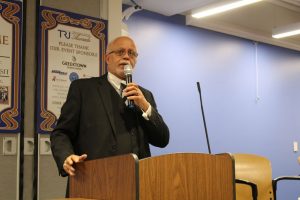 |
| L. Brooks Patterson DETROIT NEWS PHOTO by José Juarez |
Actually, I am glad Brooks has finally removed the mask of "transit neutrality" he donned for the last five years. We knew he was against regional transit, but now he has acknowledged it. Now, we can move on without him.
We know he had a large hand in crafting the legislation that enabled the RTA, but he was obliged to compromise with leaders of the rest of the region, so the result was not 100% to his liking. Apparently, "compromise" and "will of the majority" are not in his vocabulary.
Four-county regional transit is necessary. It IS possible...but not now. Patterson, together with Macomb County Executive Mark Hackel, have been doing everything possible to slow down the process, limit the free flow of resources, tailor the RTA Board rules so as to make action as nearly impossible as they can, and tie down the RTA with unrealistic accounting requirements. The RTA legislation requires 85% of each county's RTA tax revenue be spent on service within that county. Rules demanded by Oakland County's Board representatives were intended to make sure that not as much as one penny more than 15% of Oakland's RTA tax revenue is spent beyond their borders at any time. It's clear that the closer we get to true regional transportation, the more obstacles they will put in the RTA's path.
Patterson's excuse about opt-out communities has some grounding in past policy, but if it's the real reason for shooting down the RTA, he has had six years to say so. At Thursday's Transportation Bonanza in Lansing (Michigan Association of Planning) I happened to speak to a planner from Livonia, one of the largest opt-out communities (though in Wayne County). Within the constraints of loyalty to his employer, he indicated there is growing disappointment with opt-out strategy there. Likewise, a young planner from the other opt-out county was shame-faced at being revealed as an employee of that county.
 |
| Wayne County Executive Warren Evans at TRU |
As in the other three counties, there is opposition to the RTA from the rural townships in Washtenaw. From their leaders, I have heard the sentiment that they are already taxed for services that go mainly to urban regions, and they don't want any more taxes without services for their region. Though there are enough votes in urban areas to overcome that opposition, I don't think it would be a smart plan. I believe any plan - whether in two counties or all four - needs to meaningfully serve low-density areas, or trim the transit district to leave out the edges. Yes, low-density areas are more expensive to serve, but I believe (subject to correction by contradictory survey results) that as a whole, the region would be willing to pay more to make that happen, at least in Wayne and Washtenaw.
Daniel Burnham's words over a hundred years ago are still true today: "Make no little plans; they have no magic to stir men's blood and probably themselves will not be realized." The RTA plan was highly constrained (by guess who) and had little or no magic to stir anyone's imagination. It came close, but perhaps we should have expected that it would not not be realized. Next time, let's strive for that element of magic!
In every US city that has experienced transit success, the first steps met with opposition. Once service began (typically on rails) the communities started clamoring for more. Voters stepped up and taxed themselves. So let's get Wayne-Washtenaw started, and move up from two-county success to four-county success.





I've been investing in transit in Ann Arbor/Washtenaw County for over 30 years and still have little to show for it, now you are suggesting that Washtenaw "Step Up" and partner with Wayne County to throw even more money away? The train doesn't even go to the airport ffs!
ReplyDeleteSigned,
Tired of footing the bill for others!